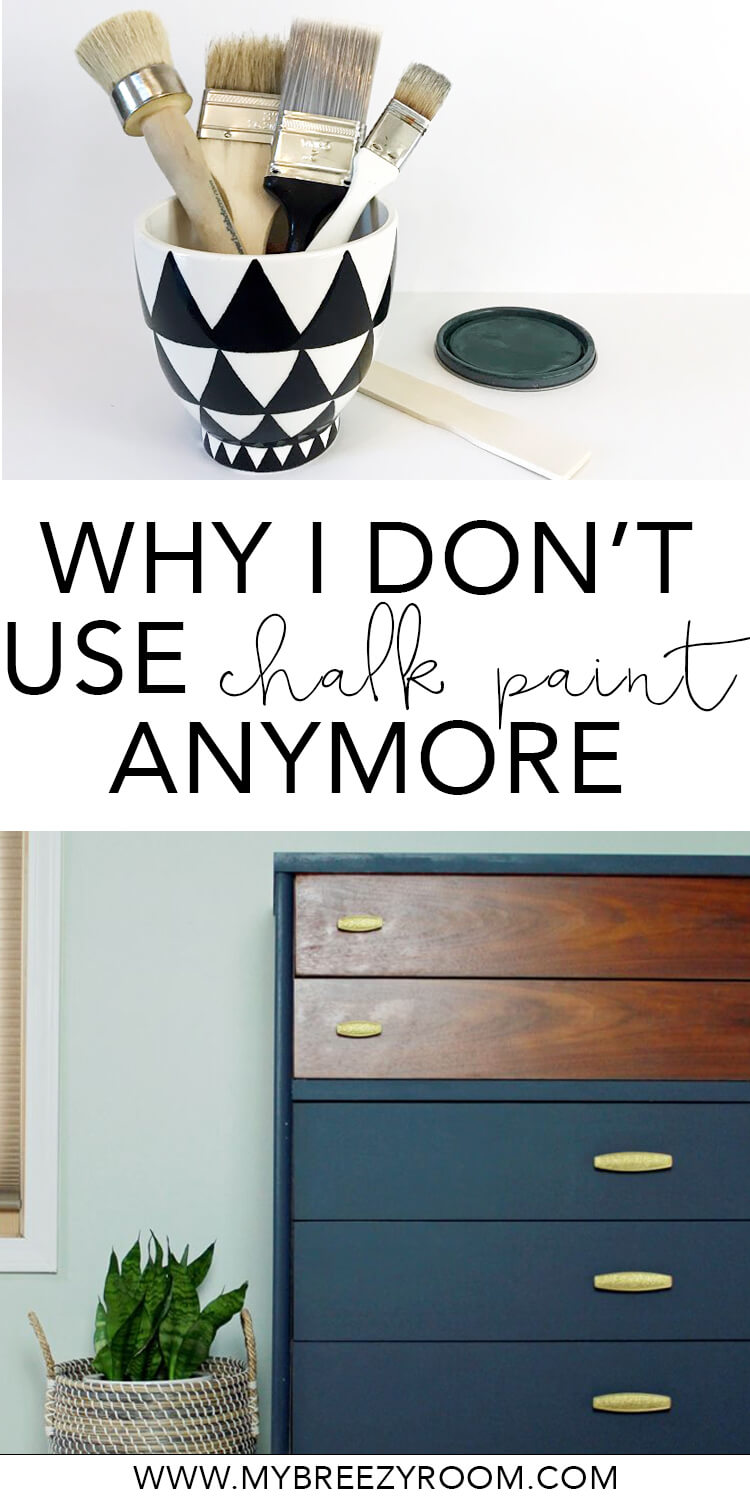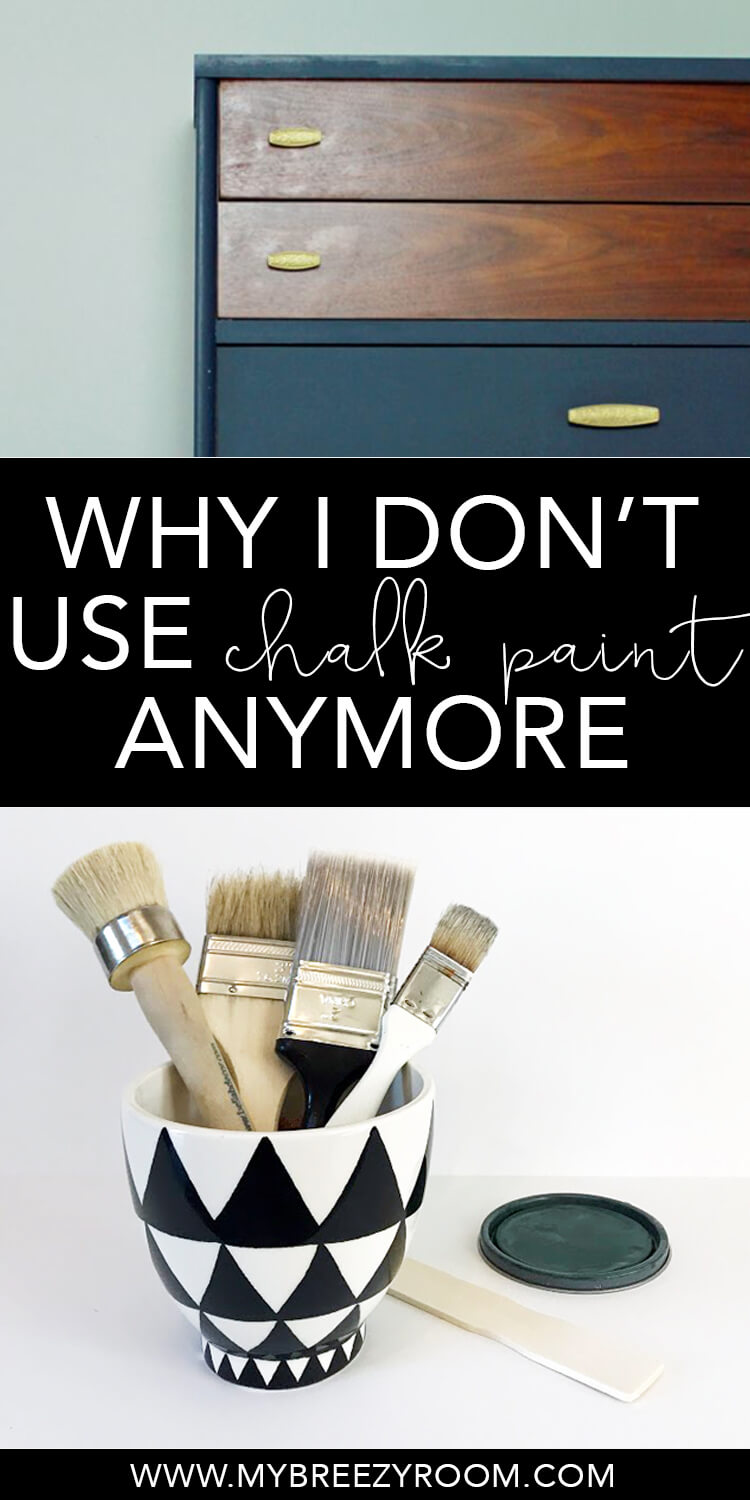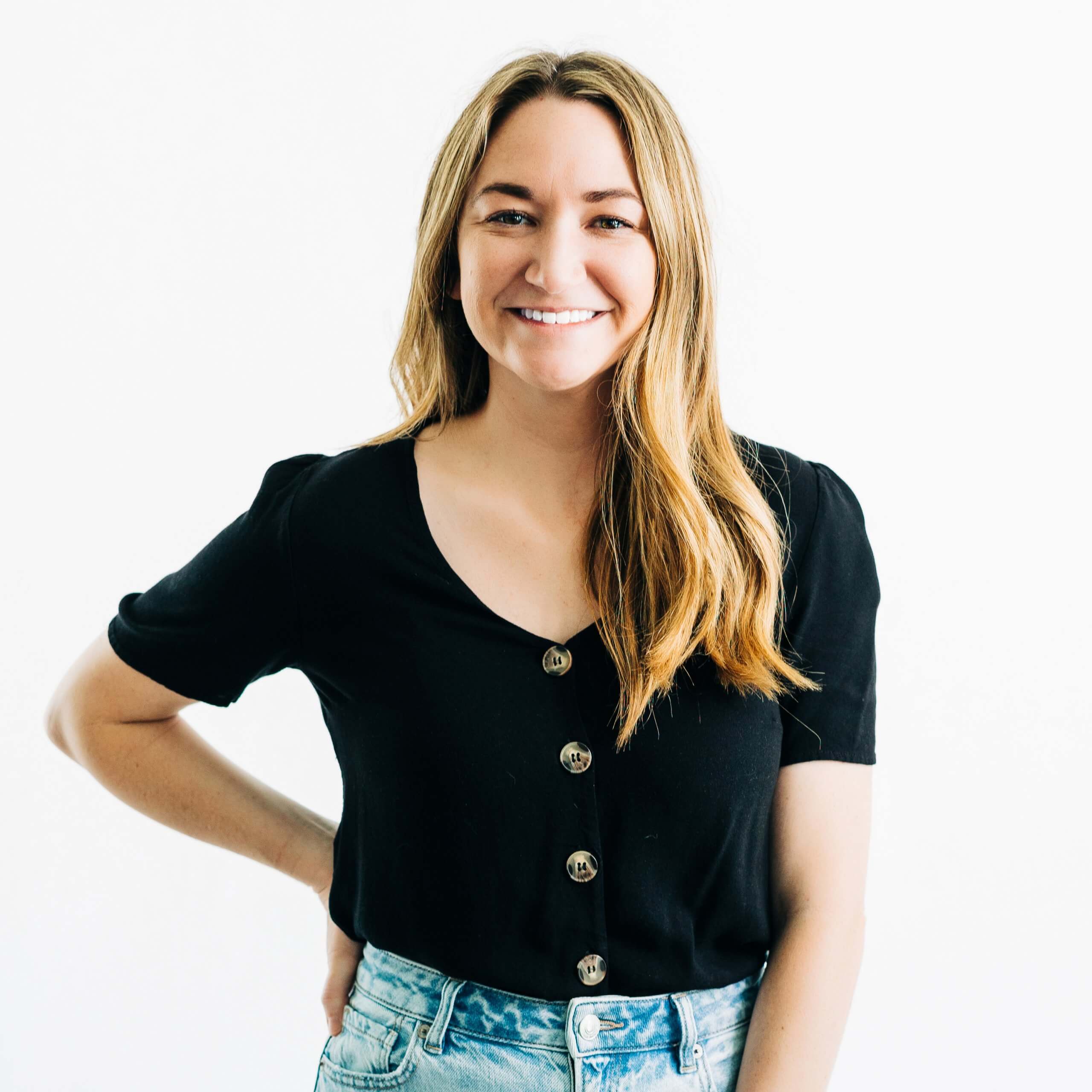When I first started painting furniture, I started off with chalk paint. It was a new product that promised to make painting easy and I think it made trying a new project less intimidating. With chalk paint you don’t have to sand or prime your furniture and it dries quickly and washes off with water for easy distressing (or for cleaning it off things you didn’t mean to paint). With all these claims, it’s hard to imagine why I don’t use chalk paint anymore.

I still think if you’re new to painting, chalk paint is a great place to start. But there are a few reasons I’ve graduated from chalk paint to latex paint and other professional paint products – I’ve used affiliates links to link to my favorite products.
3 reasons why I don’t use chalk paint
1. Chalk painting companies make promises that are too good to be true.
Chalk paint promises that you’ll never need to sand or prime your projects, but sometimes that’s simply not true. Sure you can keep layering paint colors until you can’t see the stains that leak through. But if you’re going for a smooth, clean finish, the right prepping method is helpful. The more complicated conventional process of sanding, priming, painting is tried and true and it works. It helps smooth out any rough spots in the wood and guards against bleeding through of old stains. You may not notice these things at first, but if you paint a lot of furniture, you’ll eventually run into these problems. You’ll need a good oil-based primer to completely block stains. This is the kind of primer I use.
2. Conventional products are more durable.
This is probably the biggest reason I don’t use chalk paint. Did you know you need to reapply the wax every few years? You need to reapply it even sooner for furniture in high traffic areas like chairs and tables. And it requires an entire month to fully cure. I’m willing to bet that most furniture that’s sold using chalk paint isn’t sitting around for an entire month before it’s moved to sell.
And I was never able to get the wax to completely cure. It would scrape off fairly easily even months later. I’m sure that was a user error, but I’m probably not the only one who has issues with that. I did, however, keep using chalk paint for quite some time because I had accumulated so much of it. Using a polycrylic top coat to make my furniture more durable seemed to work much better. I prefer polycrylic over polyurethane because polyurethane is known to yellow over time. I know that some brands of chalk paint make more durable finishes, but the price is still much higher than other products on the market. Which brings me to my next point.
3. The price
It’s much more reasonable for me to buy a $15 quart of latex paint or acrylic paint in multiple colors than to drop $40 per quart to build up my stash of chalk paint. And that’s just for the paint. I do invest in more expensive products now that I paint furniture for clients and have more experience – like this top coat. But you can still do a quality paint job with less expensive products.
My go to furniture painting products
Now when I’m painting a piece of furniture, I grab these 3 things and am good to go.
These 3 products are super durable and create a quality finish that lasts. The primer and top coat last for many many projects and are worth the investment, and the paint is a self leveling mineral based paint, not a true milk paint.
I never would have gotten into this business if I hadn’t discovered chalk paint brands like Annie Sloan and CeCe Caldwell’s. These are just some reasons why I don’t use it anymore for most of my furniture painting projects.
I do think chalk paint is a great place to start for beginner painters. There are many gorgeous colors available and tons of classes to teach you how to use the products, which is awesome. And I totally get it if you’re into the all natural alternatives to conventional products. I personally try to use water-based products as much as possible in well ventilated areas. I also use a respirator when using oil-based products so hopefully these precautions will keep me healthy!
If you’re using chalk paint, this is the best paint brush.
I use these brushes for SO MANY painting projects. They’re perfect to have on hand at all times whether you’re using chalk paint, acrylic paint or latex.
If you have questions about chalk paint, I’m still willing to answer them to the best of my abilities based on my experiences with the product. But if you have questions about the other products I’ve started using, I’d be happy to answer those too!
Have you tried chalk paint? Do you like it better than conventional painting products?
If you enjoyed this post, pin it to save it for later!



Diego Nieves
Wednesday 21st of October 2020
Awesome tips. thanks a lot for sharing
Arya
Friday 7th of August 2020
Thanks for this article. I am planning to paint an old furniture for the purpose of selling it. However this would be my first experience of painting a furniture. What would you recommend as I want to deliver a quality product. Please suggest. Thank you so much.
Christine
Thursday 23rd of May 2019
Hi! Came in via Pinterest. I agree with you on many fronts. -Urathane or oil based products yellowing is my biggest dislike. I have always been iffy on chalk paint, although I do love the feel of it. It has helped me develop some techniques I now use in latex/acrylic painting, though, I'd never have thought of.
Like using inexpensive paint base as a 100% matte, invisible clear topcoat, which lets the chalky feel remain. Using clear, satin polyacrylic as the base paint under crackle finishes to let the wood actually show through the crackles. Putting a hefty squirt of white glue into homemade chalk paint for even better adhesion. Stuff like that.
You just can't beat paint samples made into chalk paint for the price. That said, +glue, +polyacrylic top coat or kiss it goodbye! :)
I've never understood the insanity of waxed finishes in the kitchen. One of the cheaper ways of removing wax (not more expensive wax overtop!) is Windex. Or anything ammonia based. Not everyone thinks vinegar is the cure-all, and some of us still use the tried-and trues. No, my father isn't Greek, and no, I'm not having a big fat wedding. Anyway, one overspray of a Windex squirt removes wax, so there goes your finish!
I could go on, but I get'cha. I guess I feel I've moved past entry level painting. I invest the time for a good substrate for a strong, durable finish. Someday I'll tell 'ya about my paint stripping tricks that make it fun. But that's another day!
Barbi
Friday 2nd of October 2020
So, wait, white glue added to homemade latex = a better adhesion, or longer lasting and then finished off with polyacrylic? I want to redo a midcentury cabinet with glass doors with wood munions. The finish looks original. I definitely don't want to get ammonia on it when cleaning the glass. After reading all these differing methods I want to be clear about which is best. What is the glue ratio? Thanks for any responses.
Kala
Thursday 23rd of May 2019
I love everything you've learned from chalk painting. I agree with everything you've said here - Great takeaways! And I definitely want to know about any strategy that claims to make stripping furniture "fun" haha!
Vicki Hulsey
Monday 11th of February 2019
I painted my Kitchen cabinets previously. I did the standard way. Sanded, primed with Zinsser Cover. Lightly sanded, lightly primed again. (these were dark cherry wood cabinets). I then painted with BM paint Advanced in a Weathered White Color. Let them cure completely while I moved on. When dry, lightly scuffed and needed another coat BM ADV. The problem is the BM would never cure completely. I waited for over 2 months or even longer for the interior to load. I finally topcoated with General finished poly acrylic and they got less gooey. NOW i need to paint cabinets in a new old home. I painted a very large piece in a previous home with Belle Craie. It has been taken apart 2 times, Stored,moved long distance,crown and all and NO nicks. It is still beautiful. Used the entire Belle Craie system. Problem? too many cabinets for the cost and I want a specific color. Was going to mix my own chalk paint. Still sand,prime,paint 2 coats,polyacrylic or use Belle Craie top coat which is flat and beautiful. NOW I am confused. The drying time and the gooey feel is my hold up to the BM Advance or Cabinet Coat.HELP!!! Suggestions needed.
Kala
Tuesday 12th of February 2019
I used General Finishes Milk Paint on my cabinets and haven't had any problems. It's actually an acrylic based paint. What was the weather like when you painted them? Was it really cold or really humid? There are so many factors that go into how a paint cures it's hard to tell what happened. It does sound like you waited the appropriate amount of time between coats. I recommend waiting 24 hours. If the weather is cold or humid where you live I recommend finding a way to paint everything indoors. That would be my best guest as to what went wrong. Good luck!
Mary
Friday 28th of December 2018
While I agree there are times latex and traditional paints work, chalk paint is a title maligned in your post. Rarely does a stain bleed through chalk paint unless you are painting over raw wood. As to durability, I've had no problems with Annie Sloan chalk paint and proper waxing. I even use an electric car polisher with hand polishing in hard to reach spots. The natural look of chalk paint and wax is far superior to the fake painted look created by latex in my opinion. Poly made by Varathane is crystal clear and guaranteed not to yellow when poly is called for. Just to address the pros and cons of both types of paint. Where raw wood is painted, there are certain techniques to prevent bleed through of the tannins in the wood.